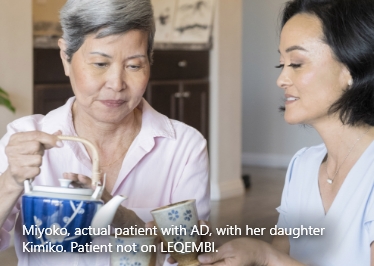

About LEQEMBI®
Learn more about the Phase 3 Clarity AD trial
Study design
Clarity AD is an 18-month global, placebo-controlled, double-blind, parallel-group randomized study1
Randomization phase2


Randomization stratified according to3
- Clinical subgroup (MCI due to AD or mild AD dementia)
- Presence or absence of ongoing approved AD treatment (eg, acetylcholinesterase inhibitors, memantine, or both)
- ApoE ε4 status (ie, carriers or noncarriers)
- Geographical region
Select key inclusion criteria1,2
- Patients with MCI due to AD or mild AD dementia
- Global CDR 0.5 or 1.0 and CDR Memory Box score >0.5
- MMSE score ≥22 and ≤30
- WMS-IV LMII ≥1 SD below age-adjusted mean
- Amyloid pathology confirmed
- Aged 50 to 90 years
Select key exclusion criteria2
- Serious hypersensitivity to lecanemab-irmb or to any of the excipients of LEQEMBI
- Risk factors for intracerebral hemorrhage: neuroimaging findings suggestive of cerebral amyloid angiopathy (prior cerebral hemorrhage >1 cm in greatest diameter, >4 microhemorrhages, superficial siderosis, vasogenic edema) or other lesions (aneurysm, vascular malformation)
Patient characteristics
-
Baseline characteristics
-
Additional demographics
-
Comorbidities & comedications
In Clarity AD, the majority of patients were in the earliest symptomatic stage, MCI due to AD1,4,5


A broad population, representative of patients with MCI due to AD and mild AD dementia1


Baseline outcome measures1


In the US, LEQEMBI was studied in a broad range of patients, generally reflective of the Medicare population3,6-8
27%
enrollment of Hispanic (22.5%) and Black (4.5%) people3
63.7%
of patients had at least 2 comorbid conditions*3
5.7%
received anticoagulation3
Caution should be exercised when considering the use of LEQEMBI in patients with factors that indicate an increased risk for intracerebral hemorrhage and in particular for patients who need to be on anticoagulant therapy or patients with findings on MRI that are suggestive of cerebral amyloid angiopathy2
*Comorbid conditions include hypertension, hyperlipidemia, ischemic heart disease, diabetes, and obesity.3
See more detailed breakdowns of patient characteristics3
Population within the study was a diverse group of patients, representative of MCI due to AD and mild AD dementia1-3


AD=Alzheimer’s disease; MCI=mild cognitive impairment.
Comorbidities and comedications represented in the patient population3


Efficacy
Primary endpoint
LEQEMBI is proven to slow progression across the stages of early Alzheimer’s disease1,2,4,5
In Clarity AD, LEQEMBI met the primary endpoint at 18 months, demonstrating statistically significant efficacy in patients with MCI due to AD and mild AD dementia2
CDR-SB: Change from baseline in cognition and function at 18 months2


-
LEQEMBI showed statistical significance at all time points beginning at 6 months2
Continued treatment with LEQEMBI demonstrated clinically meaningful slowing of cognitive and functional decline with increasing separation vs placebo through 18 months2
CDR-SB is a validated outcome measure that consists of the following domains1,9:
Cognition
Memory
(eg, recalling recent/distant events)
Orientation
(eg, time relationships, navigating familiar territory)
Judgment/problem solving
Function
Memory
(eg, recalling recent/distant events)
Orientation
(eg, time relationships, navigating familiar territory)
Judgment/problem solving
-
Community affairs
(eg, ability to work, socialize, and/or shop)
-
Home and hobbies
(eg, household tasks and activities)
-
Personal care
(eg, dressing, washing, using bathroom)
Scoring:
- Each domain can be scored as 0, 0.5, 1, 2, or 3, for a total scale range from 0-181,3
- Higher scores indicate more advanced AD1,3
- MCI and mild AD dementia tend to score 0.5 or 1 in each domain3
Clarity AD ongoing long-term extension (LTE)
36-month evaluation of patients receiving LEQEMBI
Study description12:
- Clarity AD LTE is a global, open-label, single-arm study evaluating LEQEMBI in patients with early AD for up to 48 months.* Participants who completed the Core study (LEQEMBI or placebo arm) and were eligible as determined at study initiation could continue in the LTE
- Patients enrolled in the Core study (Clarity AD) were given the option to participate in the Extension phase (18-48 months), regardless of whether they were from the treated or placebo arm of the Core study (Clarity AD)
- All patients participating in the Extension phase received LEQEMBI with the same dose and schedule as in the Core study (Clarity AD)
Primary objective12
To evaluate the long-term safety and tolerability of LEQEMBI and to evaluate whether the long-term effect of LEQEMBI, as measured by CDR-SB at the end of the Core study (Clarity AD), is maintained over time in the Extension phase (18-48 months)
- LEQEMBI (Core) patients continued on LEQEMBI (LTE) following the Core 18-month study
- Placebo (Core) patients switched to LEQEMBI (LTE) following the Core 18-month study
LEQEMBI observational data through 36 months,
including the ADNI cohort
ADNI arm is an untreated observational cohort13,14
- ADNI is a global (US and Canada) research study that follows the natural progression of AD, including imaging, biomarkers, genetics, and neurocognitive tests, and that actively evaluates the investigation and development of treatments for AD
- ADNI cohort (N=436 at baseline, followed for 36 months) was pre-specified to aid in the design of the Clarity AD study and was selected to match participants from the Core study (Clarity AD) population, based on demographics and clinical characteristics
Ongoing treatment with LEQEMBI® showed continued benefit out to 3 years1,13

95%
of patients who completed the core trial opted to continue in the LTE. Data at 3 years shows continued separation in CDR-SB scores vs a historical control line in a untreated observational cohort (ADNI)2,13

95%of patients who completed the core trial opted to continue in the LTE. Data at 3 years shows continued separation in CDR-SB scores vs a historical control line in a untreated observational cohort (ADNI)2,13

LTE data limitations:
Patients were enrolled in the LTE after completion of the controlled period and
are subject to continued dropout. Exploratory interim analysis at 36 months was not prespecified. The
LTE data measured in this study was not powered to conclude statistical significance. Conclusions
regarding the treatment effect of LEQEMBI cannot be drawn on the basis of LTE data.12,13
ADNI data limitations:
This retrospective analysis for ADNI should not be interpreted to determine a
treatment difference between Core study (Clarity AD) and LTE because of potential selection bias, small
sample size, and that the analysis was not statistically powered. This is not a head-to-head study
between the ADNI and Core study (Clarity AD) and conclusions regarding the treatment effect of
LEQEMBI cannot be drawn on the basis of LTE data.13,14
ADNI participants were not part of the Core study (Clarity AD); instead, they were exclusively
used as a historical control line in this observational analysis.13
LEQEMBI safety profile was analyzed through 36 months in the LTE study† and was consistent with the Core study (Clarity AD)13
- *The LTE study will continue through 48 months, except for subjects in Sweden, who will continue for 36 months.12
- †Cut off March 31, 2024. The LTE study is ongoing, including safety data collection and analysis.12,13
- ‡At 18 months in the newly treated Core placebo arm: 7.1% (n=51) of participants had moderate AD and 1.0% (n=7) had severe AD as measured by CDR-G.13
Secondary endpoints
LEQEMBI: Consistent results across all key secondary endpoints2
-
ADCS MCI-ADL
-
ADAS-Cog14
-
Brain Amyloid Beta
LEQEMBI significantly slowed disease progression by 37% on the ADCS MCI-ADL scale at 18 months2,3
ADCS MCI-ADL: Change from baseline in function at 18 months


Slowing of functional decline was statistically significant with LEQEMBI at all time points beginning at 6 months, becoming more pronounced over time2,3
ADCS MCI-ADL measures activities of daily living, including1,12,16:
Function
Travel
Go shopping
Keep appointments
Make a meal
Clean room
Clean laundry
Balance banking
Use a telephone
Left on his/her own
Use household appliance
Perform pastime
Find personal belongings
Write things down
Select first set of clothes
Talk about current events
Read more than 5 minutes
Usual dressing
Watch television
Scoring1,3:
- 0-53 points, where lower scores indicate greater impairment
LEQEMBI significantly slowed disease progression by 26% on the ADAS-Cog14 scale at 18 months1-3
ADAS-Cog14: Change from baseline in cognition at 18 months2,3


Slowing of cognitive loss was statistically significant with LEQEMBI at all time points beginning at 6 months3
ADAS-Cog14 measures aspects of cognition, including12,17,18:
Cognition
Memory
Orientation
Attention
Executive function
Language
Praxis (practical application of knowledge/skills)
Scoring1,3:
- 0 to 90 points (a composite of 14 items with varying scores)
- Higher scores indicate greater impairment
ADAS-Cog14=Alzheimer’s Disease Assessment Scale-Cognitive Subscale 14-item version; ADCOMS=Alzheimer’s Disease Composite Score; ADCS MCI-ADL=Alzheimer’s Disease Cooperative Study-Activities of Daily Living Scale for Mild Cognitive Impairment; SE=standard error.
LEQEMBI significantly reduced brain amyloid burden at all time points beginning at 3 months3
An average of 22.4 CL was reached at 18 months—below the cutoff for Aβ plaque clearance* (30 CL)3,5


Adjusted mean Aβ by PET (CL):
Plaque clearance reached at 12 months—below the cutoff for Aβ plaque clearance (30 CL)3
22.4 CL was reached at 18 months1
*Aβ plaque clearance (defined as <30 CL) achieved at the population level (mean) at 12 months for patients treated with LEQEMBI.3
†73 subjects were not included at 18 months (per statistical analysis plan) since their PET assessments were performed after receiving LEQEMBI in the Extension phase.3
Note: Based on pharmacodynamic analysis population (PET substudy population). Adjusted mean change from baseline, SE, and P-value are derived using MMRM with treatment group, visit, treatment group-by-visit interaction, clinical subgroup, use of AD symptomatic medication at baseline, ApoE ɛ4 carrier status, region, baseline value-by-visit interaction as fixed effects, and baseline value as covariate.3
Aβ=amyloid beta; AD=Alzheimer’s disease; ADAS-Cog14=Alzheimer’s Disease Assessment Scale-Cognitive Subscale 14-item version; ADCOMS=Alzheimer’s Disease Composite Score; ADCS MCI-ADL=Alzheimer’s Disease Cooperative Study-Activities of Daily Living Scale for Mild Cognitive Impairment; ApoE ε4=apolipoprotein E ε4; CL=Centiloids; MMRM=mixed model for repeated measures; PET=positron emission tomography; SE=standard error.
Tau PET substudy
In Clarity AD, a post hoc analysis evaluated CDR-SB scores
in a tau PET substudy
Baseline characteristics generally similar across tau populations with exception of amyloid load15

Study Design1,15,19
The predefined optional tau PET substudy looked at outcomes stratified by the participants’ level of the brain tau aggregates (tau PET) as well as correlations of tau data to clinical outcomes. Post hoc analyses stratified patients by low, intermediate, and high levels of brain tau aggregates using the Cerveau database of tau PET (N=342).
Of the total population included in this analysis (MK-6240 tau PET whole cortical gray matter), 141 patients (41.2%) had low tau levels (SUVR <1.06), 191 (55.8%) had intermediate tau levels (SUVR ≥1.06, ≤2.91), and 10 (2.9%) had high tau levels (SUVR >2.91).
An exploratory post hoc analysis of early AD patients with varying tau levels and the effect on their CDR-SB scores was performed. Further analyses were conducted in the low-tau group to measure the change from baseline on the CDR-SB.
Of the patients who had low tau levels, 61% (n=86/141) were considered to have MCI due to AD15
CDR-SB results across tau levels15


Limitations: These post hoc exploratory analyses reflect data from the tau PET subgroup of the Clarity AD study. The analyses were limited by small sample size and were not adjusted for multiplicity; as such no conclusions can be drawn.15
CDR-SB measures cognition and function. An increase in score=increased impairment, and a decrease in score=decreased impairment1
76% of patients with early AD and low tau levels showed no worsening in CDR-SB scores compared with baseline15,19
Observed rates of no worsening as measured by CDR-SB in the low-tau PET group at 18 months

Limitations: These post hoc exploratory analyses reflect data from the tau PET
subgroup of the Clarity AD study. The analyses were limited by small sample size
and were not adjusted for multiplicity; as such no conclusions can be drawn.15
60% of patients with early AD and low tau levels showed an improvement as measured by the CDR-SB compared with baseline15,19
Observed rates of improvement as measured by CDR-SB in the low-tau PET group at 18 months

Limitations: These post hoc exploratory analyses reflect data from the tau PET
subgroup of the Clarity AD study. The analyses were limited by small sample size
and were not adjusted for multiplicity; as such no conclusions can be drawn.15
Efficacy results by ApoE ε4 status2
Both ApoE ε4 carriers and ApoE ε4 noncarriers showed statistically significant treatment differences for the primary endpoint and all secondary endpoints
In an exploratory subgroup analysis of ApoE ε4 homozygotes, which represented 15% of the trial population, a treatment effect was not observed with LEQEMBI treatment on the primary endpoint, CDR-SB, compared to placebo
- Treatment effects that favored LEQEMBI were observed for the secondary clinical endpoints, ADAS-Cog 14 and ADCS MCI-ADL
- Treatment effects on disease-relevant biomarkers (Aβ PET, plasma Aβ42/40 ratio, plasma P-tau181) also favored LEQEMBI in the ApoE ε4 homozygous subgroup
Limitations: Exploratory endpoints were not adjusted for multiplicity; therefore, no conclusions can be drawn.
Impact on fluid biomarkers of AD pathophysiology and neurodegeneration
A reduction in plasma P-tau181, CSF P-tau181, and CSF T-tau was observed with LEQEMBI 10 mg/kg every 2 weeks compared to placebo2


N is the number of patients with baseline value.2
*Results should be interpreted with caution due to uncertainties in bioanalysis.2
†Month 18 represents Week 79 in Study 1 and Week 77 in Study 2.2
‡P-values were not statistically controlled for multiple comparisons.2
Additional biomarkers


Limitations: Prespecified exploratory endpoints were not adjusted for multiplicity; therefore, no conclusions can be drawn.2
Exploratory clinical endpoint
Prespecified exploratory slope analysis of CDR-SB based on observed data3


Cognition & function: Patients on LEQEMBI took 5.3 months longer to reach the same level of cognitive and functional decline as placebo3
Note: Rate of change over time (mean slope) based on change from baseline in the CDR-SB was analyzed using linear mixed effects (LME) model. LME model included time, treatment by assessment time as covariate with random intercept and slope.3
Limitations: Prespecified exploratory endpoints were not adjusted for multiplicity, and therefore no conclusions can be drawn.3,12
Exploratory QOL endpoints
LEQEMBI: Evaluation of impact on patient QOL and caregiver burden
Exploratory analyses: Measures of patient health–related quality of life and caregiver burden at 18 months3,12


Limitations: Prespecified exploratory endpoints were not adjusted for multiplicity, and therefore no conclusions can be drawn12
European Quality of Life–5 Dimensions (5-level version) (EQ-5D-5L)3:
Covers 5 dimensions of health:
- Mobility, self-care, usual activities, pain or discomfort, and anxiety or depression
Covers 5 levels of severity in each dimension:
- No problems, slight problems, moderate problems, severe problems, and unable to perform or extreme problems
The score being presented is the Health Today VAS (Visual Analog Scale subtotal)
Quality of Life in Alzheimer’s Disease (QOL-AD)3:
A 13-item questionnaire designed to provide both a patient and a caregiver (participant by proxy) report of the QOL for patients who have been diagnosed with AD
Zarit Burden Interview3:
The 22-item instrument used in dementia caregiving research to assess the stresses experienced by study partners of subjects with dementia


Safety
Safety matters.
The incidence and timing of ARIA varies among treatments.
WARNINGS AND PRECAUTIONS: ARIA
Clarity AD: Incidence of ARIA1,2


*Including asymptomatic radiographic events.2
ARIA-E: ARIA with edema can be observed on MRI as brain edema or sulcal effusions.2
ARIA-H: ARIA with hemosiderin deposition includes microhemorrhage and superficial siderosis.2
ARIA is a consequence of amyloid presence in blood vessel walls that can occur spontaneously in patients with AD or as a result of treatment with a monoclonal antibody (such as LEQEMBI) that removes amyloid2,20,21
- Symptomatic ARIA occurred in 3% of patients and serious ARIA symptoms in 0.7% with LEQEMBI2
- Clinical symptoms associated with ARIA resolved in 79% (23/29) of patients during the period of observation2
- In patients with symptomatic ARIA, commonly reported symptoms include headache, confusion, visual changes, dizziness, nausea, and gait difficulty2
- ARIA-H that occurred with ARIA-E tended to occur early (within 6 months)1
- There was no increase in isolated ARIA-H (ie, ARIA-H in patients who did not also experience ARIA-E) for LEQEMBI compared to placebo2
Factors to consider for ARIA
The incidence of ApoE ε4 status and risk of ARIA in Clarity AD2


- Serious events of ARIA occurred in 3% of ApoE ε4 homozygotes and approximately 1% of heterozygotes and noncarriers2
Role of risk factors for ARIA and intracerebral hemorrhage2
ApoE ε4 status:
- Testing for ApoE ε4 status should be performed prior to initiation of treatment to inform the risk of developing ARIA
- Prior to testing, prescribers should discuss with patients the risk of ARIA across genotypes and the implications of genetic testing results
- Prescribers should inform patients that if genotype testing is not performed, they can still be treated with LEQEMBI; however, it cannot be determined if they are ApoE ε4 homozygotes and at higher risk for ARIA
- Currently available tests used to identify ApoE ε4 alleles may vary in accuracy and design. The recommendations on management of ARIA do not differ between ApoE ε4 carriers and noncarriers
Concomitant use of antiplatelet or anticoagulant and additional risk factors:
- Caution should be exercised when considering the use of LEQEMBI in patients with factors that indicate an increased risk for intracerebral hemorrhage and in particular for patients who need to be on anticoagulant therapy or patients with findings on MRI that are suggestive of cerebral amyloid angiopathy
- Additional caution should be exercised when considering the administration of antithrombotics or a thrombolytic agent (eg, tissue plasminogen activator) to a patient already being treated with LEQEMBI
Radiographic ARIA with LEQEMBI2


- The majority of ARIA-E radiographic events occurred within the first 7 doses of treatment, although ARIA can occur at any time and patients can have more than 1 episode2
- Resolution of ARIA-E on MRI occurred in 52% by 12 weeks, 81% by 17 weeks, and 100% overall after detection2
Individualizing risk assessments for ARIA2 and intracerebral hemorrhage
When deciding to initiate treatment with LEQEMBI, consider the potential risk of serious adverse events associated with ARIA and intracerebral hemorrhage, and benefit of LEQEMBI for the treatment of Alzheimer’s disease
-
The risk of ARIA, including symptomatic and serious ARIA, is increased in ApoE ε4 homozygotes

[Patients with] CAA have an increased risk for intracerebral hemorrhage
Prior intracerebral hemorrhage, cerebral microhemorrhage, and cortical superficial siderosis may indicate CAA, as evidenced by neuroimaging findings
The presence of an ApoE ε4 allele is also associated with CAA
Baseline use of antithrombotic medication (aspirin, other antiplatelets, or anticoagulants) was allowed in Clarity AD if the patient was on a stable dose
Most exposures to antithrombotic medications were to aspirin
Antithrombotic medications taken with LEQEMBI did not increase the risk of ARIA
-
Intracerebral hemorrhage occurred in 0.9% (3/328) of patients taking LEQEMBI with a concomitant antithrombotic medication at the time of the event compared to 0.6% (3/545) of those who did not receive an antithrombotic. Patients taking LEQEMBI with an anticoagulant alone or combined with an antiplatelet medication or aspirin had an incidence of intracerebral hemorrhage of 2.5% (2/79 patients) compared to none in patients on placebo
-
Fatal cerebral hemorrhage has occurred in a patient taking an anti-amyloid monoclonal antibody in the setting of focal neurologic symptoms of ARIA and the use of a thrombolytic agent
-
Because ARIA-E can cause focal neurologic deficits that can mimic an ischemic stroke, treating clinicians should consider whether such symptoms could be due to ARIA-E before giving thrombolytic therapy in a patient being treated with LEQEMBI
-
Caution should be exercised when considering the use of LEQEMBI in patients with factors that indicate an increased risk for intracerebral hemorrhage and in particular for patients who need to be on anticoagulant therapy or patients with findings on MRI that are suggestive of cerebral amyloid angiopathy
-
Additional caution should be exercised when considering the administration of antithrombotics or a thrombolytic agent (eg, tissue plasminogen activator) to a patient already being treated with LEQEMBI
Rates of ARIA with concurrent antiplatelet or anticoagulant use relative to LEQEMBI alone22

Limitations: Exploratory subgroup analyses with a small sample size; therefore, no conclusions can be drawn.
*Includes 1 case on placebo and 1 case on LEQEMBI with intracerebral hemorrhage >30 days after discontinuing study medication.22
Warnings and precautions (Cont’d)
Hypersensitivity reactions2
- Hypersensitivity reactions, including angioedema, bronchospasm, and anaphylaxis, have occurred in patients who were treated with LEQEMBI
- Promptly discontinue the infusion upon the first observation of any signs or symptoms consistent with a hypersensitivity reaction, and initiate appropriate therapy
- LEQEMBI is contraindicated in patients with a history of serious hypersensitivity to lecanemab-irmb or to any of the excipients of LEQEMBI
Infusion-related reactions2,3
- Infusion-related reactions were observed in 26% (237/898) of patients treated with LEQEMBI compared to 7% (66/897) of patients on placebo; and the majority (75%, 178/237) occurred with the first infusion
- The majority of IRRs were mild (69%, 163/237) or moderate (28%, 67/237)
- IRRs resulted in discontinuations in 1% (12/898) of patients treated with LEQEMBI
- Symptoms of IRRs include fever and flu-like symptoms (chills, generalized aches, feeling shaky, and joint pain), nausea, vomiting, hypotension, hypertension, and oxygen desaturation
- In the event of an IRR, the infusion rate may be reduced, or the infusion may be discontinued, and appropriate therapy initiated as clinically indicated
- Prophylactic treatment with antihistamines, acetaminophen, nonsteroidal anti-inflammatory drugs, or corticosteroids prior to future infusions may be considered
Most common adverse reactions2
Clarity AD: Adverse reactions reported in ≥5% of patients treated with LEQEMBI 10 mg/kg every 2 weeks and ≥2% higher than placebo in Study 2


*ARIA-H: ARIA-H microhemorrhage.
†Rash includes acne, erythema, infusion site rash, injection site rash, rash, rash erythematous, rash pruritic, skin reactions, and urticaria.2
- 7% of patients discontinued LEQEMBI due to an adverse reaction compared to 3% of patients on placebo
- The most common adverse reaction leading to discontinuation of LEQEMBI was ARIA-H microhemorrhages that led to discontinuation in 2% (15/898) of patients treated with LEQEMBI compared to <1% (1/897) of patients on placebo
No new safety findings were observed with continued LEQEMBI treatment
Safety profile through 36 months in the long-term extension (LTE) study*13
Adverse events and incidence of ARIA with LEQEMBI over time13

- *Cut off March 31, 2024. The LTE study is ongoing, including safety data collection and analysis.12,13
- †Includes all post-treatment events.13


